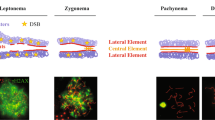Abstract
Cell cycle checkpoints and tumor suppressor gene functions appear to be required for the maintenance of a stable genome in proliferating cells. In this study chromosomal destabilization was monitored in relation to telomere structure, lifespan control and G2 checkpoint function. Replicative senescence was inactivated in secondary cultures of human skin fibroblasts by expressing the human papillomavirus type 16 (HPV-16) E6 oncoprotein to inactivate p53. Chromosome aberrations were enumerated during in vitro aging of isogenic control (F5neo) and HPV-16E6-expressing (F5E6) fibroblasts. We found that structural and numerical aberrations in chromosomes were significantly increased in F5E6 cells during aging in vitro and fluorescence in situ hybridization (FISH) analysis using chromosome-specific probes demonstrated the occurrence of rearrangements involving chromosome 4 and 6 in genetically unstable F5E6 cells. Flow cytometry and karyotypic analyses revealed increased polyploidy and aneuploidy in F5E6 cells only at passages >16, although these cells displayed defective mitotic spindle checkpoint function associated with inactivation of p53 at passages 5 and 16. G2 checkpoint function was confirmed to be gradually but progressively inactivated during in vitro aging of E6-expressing cells. Aging of F5neo fibroblasts was documented during in vitro passaging by induction of a senescence-associated marker, pH 6.0 lysosomal β-galactosidase. F5E6 cells displayed extension of in vitro lifespan and did not induce β-galactosidase at high passage. Erosion of telomeres during in vitro aging of telomerase-negative F5neo cells was demonstrated by Southern hybridization and by quantitative FISH analysis on an individual cell level. Telomeric signals diminished continuously as F5neo cells aged in vitro being reduced by 80% near the time of replicative senescence. Telomeric signals detected by FISH also decreased continuously during aging of telomerase-negative F5E6 cells, but telomeres appeared to be stabilized at passage 34 when telomerase was expressed. Chromosomal instability in E6-expressing cells was correlated (P<0.05) with both loss of telomeric signals and inactivation of G2 checkpoint function. The results suggest that chromosomal stability depends upon a complex interaction among the systems of telomere length maintenance and cell cycle checkpoints.
Similar content being viewed by others
Author information
Authors and Affiliations
Rights and permissions
About this article
Cite this article
Filatov, L., Golubovskaya, V., Hurt, J. et al. Chromosomal instability is correlated with telomere erosion and inactivation of G2 checkpoint function in human fibroblasts expressing human papillomavirus type 16 E6 oncoprotein. Oncogene 16, 1825–1838 (1998). https://doi.org/10.1038/sj.onc.1201711
Received:
Revised:
Accepted:
Published:
Issue Date:
DOI: https://doi.org/10.1038/sj.onc.1201711
- Springer Nature Limited
Keywords
This article is cited by
-
Telomere dysfunction and loss of p53 cooperate in defective mitotic segregation of chromosomes in cancer cells
Oncogene (2006)
-
Telomere erosion and chromosomal instability in cells expressing the HPV oncogene 16E6
Oncogene (2004)
-
Regulation of the G2/M transition by p53
Oncogene (2001)
-
The role of the E6-p53 interaction in the molecular pathogenesis of HPV
Oncogene (1999)
-
Telomere dynamics, end-to-end fusions and telomerase activation during the human fibroblast immortalization process
Oncogene (1999)




